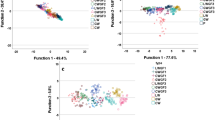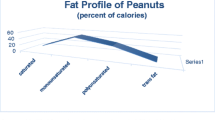Abstract
Two durum wheat bread samples produced using the same re-milled semolina but different leavening agents (sourdough and compressed yeast) have been considered in this study. Chemical composition, color characteristics, lutein content and starch digestibility have been addressed in both samples. In addition, to evaluate possible modifications induced on the protein structure attributable to the different leavening agents used, the secondary structure of proteins was also studied by Fourier transform infrared spectroscopy. The crumb of bread sample produced by compressed yeast exhibited a higher yellow index compared to the other sample but this difference was completely lost in crust because of the high baking temperature applied. Lutein resulted more preserved after the yeast fermentation due to the shorter time required for the fermentation with respect to sourdough. Total starch and resistant starch content resulted comparable in the two samples with the latter about 1% in both samples. The infrared spectroscopic study of the protein amide I band showed the lack of the random coil structure, related to the protein denaturation, and negligible changes in the relative ratios among the α-helix, β-sheet and β-turn secondary structures of proteins.



Similar content being viewed by others
References
Pasqualone A (2012) Italian durum wheat bread. In: Pedrosa Silva Clerici MT (ed) Bread consumption and health. Nova Science Publisher, New York, pp 57–79
Pasqualone A, Caponio F, Simeone R (2004) Quality evaluation of re-milled durum wheat semolinas used for bread-making in Southern Italy. Eur Food Res Technol 219:630–634
Poutanen K, Flander L, Katina K (2009) Sourdough and cereal fermentation in a nutritive perspective. Food Microbiol 26:693–699
Liukkonen KH, Katina K, Wilhelmson A, Myllymaki O, Lampi AM, Kariluoto S, Piironen V, Heinonen SM, Nurmi T, Adlercreutz H, Peltoketo A, Pihlava JM, Hietaniemi V, Poutanen K (2003) Process-induced changes on bioactive compounds in whole grain rye. Proc Nutr Soc 62:117–122
Hidalgo A, Brandolini A, Pompei C (2010) Food carotenoids evolution during pasta, bread and water biscuit preparation from wheat flours. Food Chem 121:746–751
Vogrincic M, Timoracka M, Melichacova S, Vollmannova A, Kreft I (2010) Degradation of rutin and polyphenols during the preparation of tartary buckwheat bread. J Agric Food Chem 58:4883–4887
Leenhardt F, Lyan B, Rock E, Boussard A, Potus J, Chanliaud E, Remesy C (2006) Wheat lipoxygenase activity induces greater loss of carotenoids than vitamin E during breadmaking. J Agric Food Chem 54:1710–1715
Liljeberg H, Akerberg A, Bjorck I (1996) Resistant starch formation in bread as influenced by choice of ingredients or baking conditions. Food Chem 56(4):389–394
Scazzina F, Del Rio D, Pellegrini N, Brighenti F (2009) Sourdough bread: starch digestibility and postprandial glycemic response. J Cereal Sci 49:419–421
De Angelis M, Coda R, Silano M, Minervini F, Rizzello CG, Di Cagno R, Vicentini O, De Vincenzi M, Gobbetti M (2006) Fermentation by selected sourdough lactic acid bacteria to decrease coeliac intolerance to rye flour. J Cereal Sci 43:301–314
Nionelli L, Rizzello CG (2016) Sourdough-based biotechnologies for the production of gluten-free foods. Foods 5:65. https://doi.org/10.3390/foods5030065
Barth A (2007) Infrared spectroscopy of proteins. Biochim Biophys Acta 1767:1073–1100
Dyson HU, Wright PE (1990) Peptide conformation and protein folding. Curr Opin Struct Biol 3:60–65
ISO 2171 (2007) Cereals, pulses and by-products. Determination of ash yield by incineration. International Organization for Standardization, Geneva
ICC (2003) Determination of crude protein in cereals and cereal products for food and for feed (method 105/2). Determination of the Moisture content of cereals and cereal products (method 110/1). International Association for Cereal Science and Technology. The Association, Vienna
Metodi ufficiali di analisi dei cereali. Determinazione delle sostanze grasse totali. Metodo per idrolisi acida. Serie Generale n.186 del 10-08-1994- Suppl n. 114
Acquistucci R, Melini V, Carbonaro M, Finotti E (2013) Bioactive molecules and antioxidant activity in durum wheat grains and related millstream fractions. Int J Food Sci Nutr 64:959–967
Zupan J (1989) Algorithms for chemists. Wiley, New York
Savitzky A, Golay MJE (1964) Smoothing and differentiation of data by a simplified least squares method. Anal Chem 36:1627–1639
Noda I (2008) Scaling techniques to enhance two-dimensional correlation spectra. J Mol Struct 883:216–227
Mecozzi M, Scarpiniti M (2013) An empirical and semi blind algorithm for resolving overlapped peaks in chromatography: application to the analysis of environmental samples. APCBEE Procedia 5:145–151
Mecozzi M, Sturchio E (2015) Effects of essential oil treatments on the secondary protein structure of Vicia faba roots: a mid-infrared spectroscopic study supported by two-dimensional correlation analysis. Spectrochim Acta A 137:90–98
Raffo A, Pasqualone A, Sinesio F, Paoletti F, Quaglia G, Simeone R (2003) Influence of durum wheat cultivar on the sensory profile and staling rate of Altamura bread. Eur Food Res Technol 218:49–55
Bourekoua H, Djeghim F, Benatallah L, Zidoune MN, Wójtowicz A, Łysiak G, Różyło R (2017) Durum Wheat bread: flow diagram and quality characteristics of traditional Algerian bread Khobz Eddar. Acta Agrophys 24:405–417
Pasqualone A, Piergiovanni AR, Caponio F, Paradiso VM, Summo C, Simeone R (2011) Evaluation of the technological characteristics and bread-making quality of alternative wheat cereals in comparison with common and durum wheat. Food Sci Technol Int 17:135–142
Ahrne L, Andersson CG, Floberg P, Rosen J, Lingnert H (2007) Effect of crust temperature and water content on acrylamide formation during baking of white bread: steam and falling temperature baking. LWT Food Sci Technol 40:1708–1715
Purliis E (2010) Browning development in bakery products—a review. J Food Eng 99:239–249
Friedman M (1996) Food browning and its prevention: an overview. J Agric Food Chem 44:631–653
Acquistucci R (2000) Influence of Maillard reaction on protein modification and colour development in pasta. Comparison of different drying conditions. LWT Food Sci Technol 33:48–52
Angioloni A, Collar C (2009) Bread crumb quality assessment: a plural physical approach. Eur Food Res Technol 229:21–23
Makinde FM, Akinoso R (2014) Physical, nutritional and sensory qualities of bread samples made with wheat and black sesame (Sesamum indicum Linn) flours. Int Food Res J 21:1635–1640
Josoh YMM, Chin NL, Rahman NA, Yusof YA (2008) Bread crust thickness estimation using L a b colour system. Pertanika J Sci Technol 16:239–247
Decreto Presidente della Repubblica 9 febbraio 2001, n. 187 Regolamento per la revisione della normativa sulla produzione e commercializzazione di sfarinati e paste alimentari
Antognoni F, Mandrioli R, Bordoni A, Di Nunzio M, Viadel B, Gallego E, Villalba MP, Tomás-Cobos L, Taneyo Saa DL, Gianotti A (2017) Integrated evaluation of the potential health benefits of einkorn-based breads. Nutrients 9:1232. https://doi.org/10.3390/nu9111232
O’Connell O, Ryan L, O’Sullivan L, Aherne-Bruce SA, O’Brien NM (2008) Carotenoid micellarization varies greatly between individual and mixed vegetables with or without the addition of fat or fiber. Int J Vitam Nutr Res 78:238–246
Kean EG, Hamaker BR, Ferruzzi MG (2008) Carotenoid bioaccessibility fr om whole grain and degermed maize meal products. J Agric Food Chem 56:9918–9926
Englyst HN, Cummings JH (1990) Non-starch polysaccharides (dietary fiber) and resistant starch. Adv Exp Med Biol 270:205–225
Fardet A, Leenhardt F, Lioger D, Scalbert A, Rémésy C (2006) Parameters controlling the glycaemic response to breads. Nutr Res Rev 19:18–25
Amaral O, Guerriero CS, Gomes A, Cravo M (2016) Resistant starch production in wheat bread: effect of ingredients, baking conditions and storage. Eur Food Res. Technol 242:1747–1753
Carcea M, Salvatorelli S, Turfani V (2009) Measurement of resistant starch in cooked cereal-based foods. Qual Assur Saf Crop 1:240–245
Byler DM, Susi H (1986) Examination of the secondary structure of proteins by deconvolved FTIR spectra. Biopolymers 25:469–487
Katina K, Arendt E, Liukkonen KH, Autio K, Flander L, Poutanen K (2005) Potential of sourdough for healthier cereal products. Trends Food Sci Technol 16:104–112
Reale A, Konietzny U, Coppola R, Sorrentino E, Greiner R (2007) The importance of lactic acid bacteria for phytate degradation during cereal dough fermentation. J Agric Food Chem 55:2993–2997
Ganzle M, Loponen J, Gobbetti M (2008) Proteolysis in sourdough fermentations: mechanisms and potential for improved bread quality. Trends Food Sci Technol 19:513–521
Yu P (2004) Application of advanced syncrhroton-based-Fourier transform microspectroscopy (SR-FTIR) to animal nutrition and feed science: a novel approach. Br J Nutr 92:869–885
Carbonaro M, Maselli P, Nucara A (2012) Relationship between digestibility and secondary structure of raw and thermally treated legume proteins: a Fourier transform infrared (FT-IR) spectroscopic study. Amino Acids 43:911–921
Yang Y, Wang Z, Wang R, Sui X, Qi B, Han F, Li Y, Jiang L (2016) Secondary structure and subunit composition of soy protein in vitro digested by pepsin and its relation with digestibility. Biomed Res Int 2016:5498639. https://doi.org/10.1155/2016/5498639
Yu P (2005) Protein secondary structures (α-helix and β-sheet) at a cellular level and protein fractions in relation to rumen degradation behaviors of protein: a new approach. Brit J Nutr 94:655–665
Acknowledgements
This work was undertaken within the Project TERRAVITA financially supported by the Italian Ministry of Agricultural, Food, Forestry and Tourism Policies.
Author information
Authors and Affiliations
Corresponding author
Ethics declarations
Conflict of interest
The authors declare that they have no conflict of interest.
Compliance with ethics requirements
This article does not contain experiments with human or animal subjects.
Additional information
Publisher's Note
Springer Nature remains neutral with regard to jurisdictional claims in published maps and institutional affiliations.
Rights and permissions
About this article
Cite this article
Acquistucci, R., Melini, V., Tusa, S. et al. Effect of different leavening agents on the nutritional characteristics of two durum wheat breads. Eur Food Res Technol 245, 2173–2181 (2019). https://doi.org/10.1007/s00217-019-03324-x
Received:
Revised:
Accepted:
Published:
Issue Date:
DOI: https://doi.org/10.1007/s00217-019-03324-x




